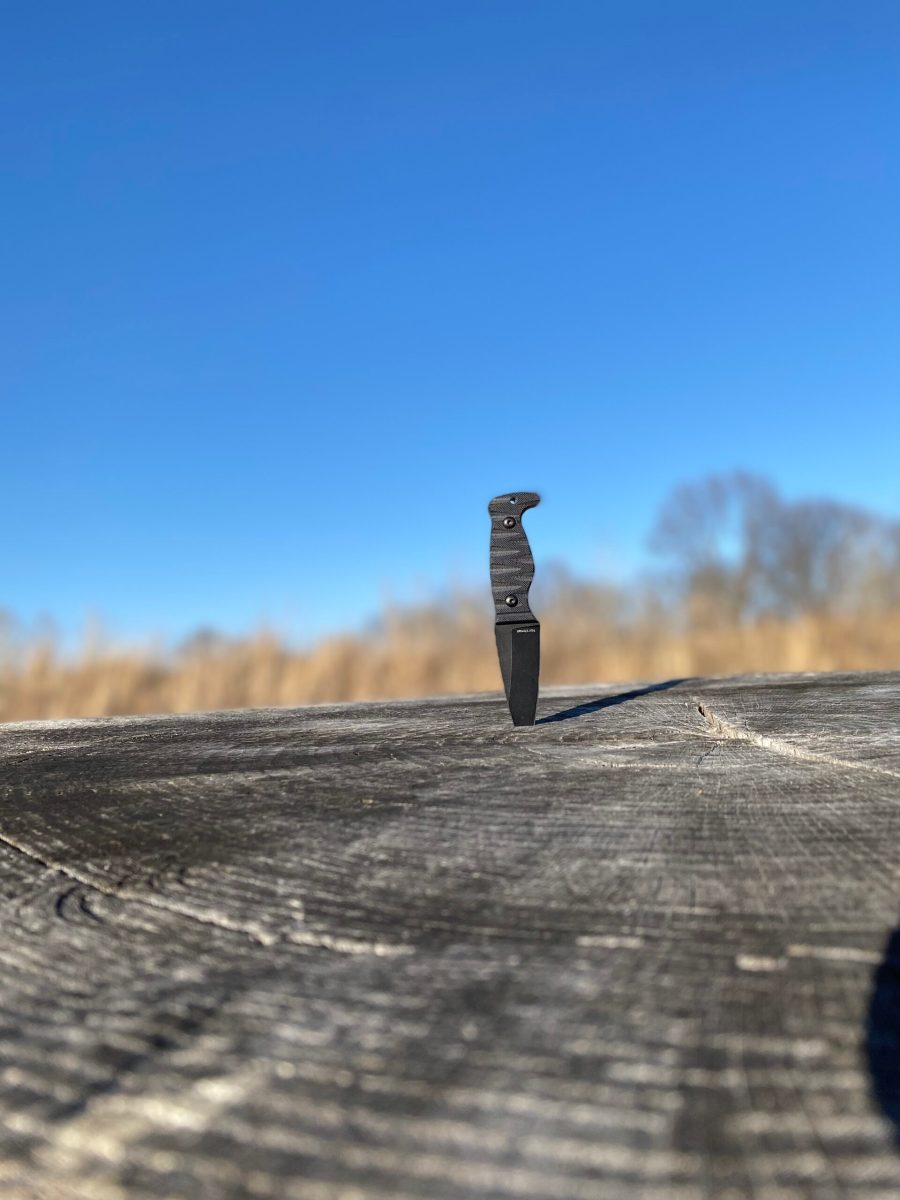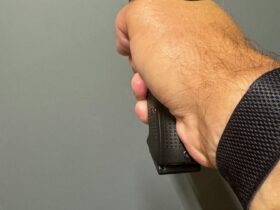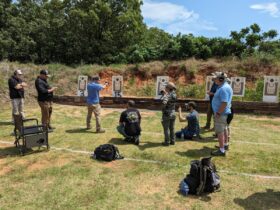Bill Rapier of AMTAC (Shooting and Blades) was kind enough to send me a couple of his knives for testing. He certainly doesn’t need my testing, though I appreciate the thought. His Northman hit the market several years ago and has been a popular EDC knife ever since. It is a very well-thought-out design and though nothing pleases everyone, it really does offer more good features than any other traditional knife I am familiar with. Bill came from a unit that was instrumental to my own tactical development and though I have not yet met the guy, he impresses me as someone who really thinks about what he does and why.
First, it is designed for either a traditional point-up and edge-forward grip or a point-down and edge-forward grip. Point up would be a saber or hammer grip and point down is an icepick grip or reverse grip, edge out. You can carry it on either side of the body, with the blade facing in either direction. Bill recommends other strong side carry (most people call that the weak side or the support side) when carrying a gun and strong side carry if no gun. I understand that is Bill’s normal advice for people, but I think that Bill also carries a blade on each side at least some of the time.
I have been using the Northman and the Magnus with plain edges. This is a combo that Bill prefers, carrying the Magnus on the other strong side (belt) and the Northman on the strong side (pocket). They have a very slight belly to the blade and end at an acute point. I worry a little about the thinness of the tip, but stabbing them into hardwood rounds has not produced any damage. I’m not trying to break them, so I have not pried them out sideways.
The handles are one of the areas where these knives really shine. The Northman handle is small, with just enough room for my hand to fit well and not contact the blade under full-force stabs. The shape and contours of the handle do a great job of filling my hand correctly and help ensure that the blade will not move in use. The Magnus has a handle that is just over .25″ longer. It also fits my hand very well, and if you have large hands, I imagine you will want one of the knives that feature a longer handle. Though it is only slightly longer, the larger handle size really provides a lot more room than the smaller handle.
The black knife below is the Northman. Hopefully the pic shows how the grip fits my size small hand. It is tight, but completely usable.
The shape of the grip is really excellent. Many knives have grips that are too thin and too round. That can lead to indexing and retention issues when using them. The AMTAC blades have flat-ish, directional handles, similar to a single stack vs. a double stack. The handle shape really lets you get a good grip on the knife. Further, the knives have a distinct punyo that lets you quickly index and draw the knife. Punyo does not translate well into English, but as all Filipino martial arts (FMA) practitioners know, it is the butt end of a stick or knife. I have not formally studied FMA in many years now but spent 10 years studying it from my teens to young adulthood. FMA gets a bad rap in today’s martial arts world, but it is very useful for learning to use an old-fashioned nightstick properly and can make a good supplemental weapons art to something like Brazilian Jiu-Jitsu.
This pic shows the training version of the Magnus. You can see how there is a tiny bit of room between my hand and the punyo. It fits me very well, but I can’t say that one fits me better than the other. The weird picture angles are to try and show the gap and fit.

The sheath of the AMTAC knives is equally well thought out. For starters, there are several sheath options, one of which is sure to fit your needs. Typically the Northman ships with a pocket fire sheath, but AMTAC will substitute any other sheath when you order, or you can add extra sheaths to your order. I have found that the belt fire sheath works best for me, given that I prefer to carry the knife on my other strong side, just in front of the hip. It clips between my belt and my pants and rides punyo forward, blade tip to the rear. This gives me quick access to the knife with either hand, though my thought process is to be able to use my other strong hand to draw it, in case my strong hand is tied up with someone or something. Weapon retention comes to mind right away, but I am a big believer that you need to be able to retain your weapon without recourse to another weapon.
The knife carries very unobtrusively and wants to naturally cant itself forward, which helps my concealment and access. You obviously don’t need a pronounced punyo in order to draw a knife, but if you have not tried a well-designed one, then you are in for a treat. The punyo on these knives really helps with a good grip and a fast draw. I draw the knife point down, edge out when using my other strong hand, and point up, edge out when using my strong hand in a cross draw. This has real utility for me, as the knife is not just a defensive tool.
The belt fire sheath that I favor has a built-in ferro rod and a small velcro envelope pocket on the back. These two features allow me to carry a decent-sized knife, along with the means to start a fire. My preferred tinder of many years now is the vaseline-soaked cotton ball. A couple of these are easy to wrap in foil or plastic wrap, and then pancake so they fit nicely in the envelope pocket on the back of the sheath. Foil is the better way to go, as you can then make char cloth in the field if you need or want to. The cotton balls not only make great fire starters, but they also work well for chapped lips and such when out in the cold. They are a multi-use item that nicely complements the multi-use nature of the AMTAC knives.
Both the standard pocket fire sheath and the belt fire sheath have the ferro rod and pocket setup. The other sheaths that are available do not come with the ferro rod or storage pocket but can allow for slimmer belt carry or deeper belt carry, depending on your specific needs.
Every AMTAC knife also comes with a blue aluminum training knife and a storage sheath. The storage sheath is to protect your live blade while training with the blue knife. The trainer has an exact copy of the grip, and the “blade” is about 1/4″ shorter than the live blade. This forces you to stab a little deeper in training so that you practice the idea of stabbing through your target. The trainers really have to be handled to be appreciated. They are as good a copy of a live blade as I have seen. Given that you will want to practice your draw a fair bit, the trainer is a very smart safety feature.
In addition to the Northman, AMTAC sent the Magnus as well. It is a 5″ blade on the slightly larger handle. I do prefer the Northman for EDC, but the Magnus is really almost as easy to carry. I find the draw a bit slower and more prone to catch on clothing as the blade has to travel an extra 1.5″ up before being brought to bear, but otherwise, they are very similar. The larger grip certainly is nice with gloves on.
Because of the size of the knife, the Magnus does not have all the sheath options that the Northman does. It ships with the belt fire sheath which is the only sheath AMTAC currently offers for the Magnus. So, I started several fires with the ferro rod on the Magnus’s sheath. There are several different ways to use a ferro rod, and normally one end of the rod is unencumbered, which makes life a little easier. Nonetheless, starting fires with my preferred cotton balls is child’s play, and is still pretty easy when using more natural options like fat wood. You just have to adjust your technique slightly, which becomes pretty obvious when you start playing around with the sheath.
In addition to some Kali practice with the knives, I worked on some weapons retention as well as some ECQC-type evolutions. There are pluses and minuses to everything, but I found the Northman to be pretty usable in all circumstances.
I have been carrying a Shivworks Clinchpick (CP) for 15 years now. It is one of the greatest purpose-built concealed carry weapons ever created. What it doesn’t do well, is all the other stuff I want to do with an EDC knife. Craig Douglas and I have discussed this at great length over the years and he has blessed off on the various custom versions of a CP that I have commissioned, in an effort to make it more chore friendly, while retaining the core ability of the CP. I mostly failed and gave up on the idea some years ago. I have carried a Swiss Army Knife for many years now, as a supplement to the CP.
The AMTAC Northman is the first knife I have used that really does offer purpose-built defensive capability while retaining a lot of the EDC chore capability that I need. Knives have always been multi-purpose tools. What is new is how well the sheath, accessories, grip, and blade design work together as a concealed carry tool. I have lots of similar knives, some from custom makers, others from various factories. The AMTAC does the job better for me than any of the others and has found a place in my toolbox





Leave a Reply